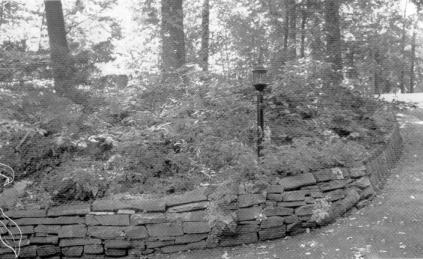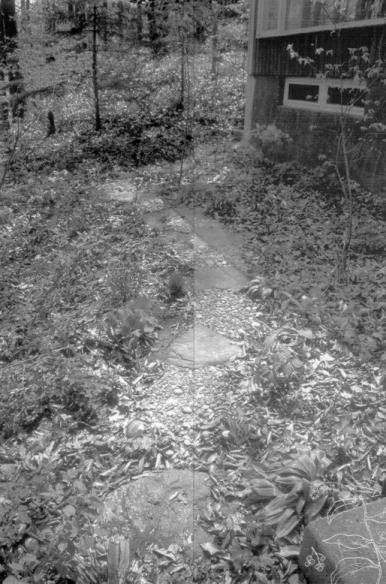Severing Roots
by Larry Lamb
(from Wildflower magazine, Spring 2001. Reprinted
with permission. Photos by Larry Lamb.)
I moved from my home with the illustrious, backyard prairie in
March 1997. It was difficult to leave my sunny, colourful prairie garden after
17 years of meticulous creation, but I was assured by the purchaser of my
property that the landscaping was appreciated and would be preserved. Well, one
additional child later, needing play space, two-thirds of the tallgrass fantasy
became sod. It has taken a while to put this behind me but everyday in my new
setting makes it easier.
I still live in Kitchener, Ontario in a 70's era bungalow on a
half-hectare of forest. Trees come up through the deck and a 20 m stretch of
clear, spring-fed, Tannery Creek courses through the back yard. The property
backs onto Bechtel Park, an approximately 45 ha woodland, with its much larger
Laurel Creek and its associated marsh and floodplain communities. The forest is
successionally late subclimax and is very diverse; mainly sugar maple, American
beech and hop hornbeam, with white ash, bur and red oaks, black cherry, blue
beech, basswood, a bitternut hickory and a large, sentinel white pine.
The understory has been little disturbed, except for where the
tile bed for the septic tank lays. The sapling layer is exceptionally diverse.
Along with the species mentioned above are: red maple, choke cherry, alternate-Ieaved
dogwood, red elderberry, American currant and to my complete delight, close to a
dozen large leatherwoods, which were highly instrumental in influencing me to
purchase the property. The herbaceous layer is pristine and is filled with
hundreds of white trilliums, including a four-petalled plant, and a few red
trilliums, including a creamy-coloured albino. The ground is carpeted with
yellow trout lily, early meadowrue, false Solomon's seal, with large patches of
zigzag goldenrod, May-apple and wild ginger. Less common are: white baneberry,
barren strawberry, blue cohosh, narrow-leaved spring beauty, Christmas fern and
several species of sedge. Adjacent to Tannery Creek, I have a 230 sq. m triangle
of cattail marsh, filled with marsh marigold, jewelweed, spotted joe-pye weed,
asters, tall meadow rue and marsh buttercup.
|

Photo by Larry Lamb
|
With this seemingly idyllic matrix to start from, one might
feel it would be cheating to claim and call the landscape a "garden",
which implies some form of artifice in its creation. In truth, a lot of work is
being done to steward the forest towards its optimal, natural condition. Without
exaggeration, I pulled, clipped and sawed out approximately 2,000 European
buckthorns and yanked out dozens of Tartarian honeysuckles, privets and
bittersweet nightshades. I removed an apple tree and four 20 m white spruces
that had snapped tops and/or blocked views. Three incredibly large pfitzer
junipers and yews, and a half dozen or so alpine currants were also hacked out.
Several eastern hemlocks, white cedars and a balsam fir were relocated for
ecological and aesthetic reasons. In addition to the above, a tremendous, time
consuming and physical effort has gone into removing periwinkle, Baltic ivy and
Japanese spurge that had invaded the yard from an adjacent property. Periwinkle
covered the entire front yard portion of the forest and Japanese spurge and
Baltic ivy covered a side yard. Previous homeowners used Baltic ivy to cover the
back walls of the house and allowed it to completely cover a large, paving stone
patio, that I didn't realize existed until I tried to put in a tree. Lily of the
valley, dame's rocket and a few daffodils planted by previous landowners have
also been eradicated. Garlic mustard was also present in small quantities and
now seems to have been eliminated.
I have been very restrictive in what is used to replace the
alien vegetation. Behind the house, I only use species that already occur in the
natural, undisturbed portions of the yard and in the adjacent park area. In
front of the house, I will only use species that occur naturally within a 15 km
or so radius of the property.
|

Photo by Larry Lamb
|
In the backyard, I have introduced several
eastern hemlocks and increased the numbers of red osier and alternate
leaved dogwoods, serviceberries, chokecherry, red elderberry and American
currant. In the front yard, I have added: pin and black cherries,
serviceberries, silky dogwood, ninebark, eastern hemlock, hackberry, bush
honeysuckle, nannyberry, highbush cranberry, running strawberry bush,
Canada yew, witch hazel, wild clematis and smooth honeysuckle. All the
tree and shrub species used are animal attracting and/or have attractive
flowers, foliage or fruit, interesting form, good fall colour or are
evergreen. I am placing a special emphasis on creating dramatic winter
interest effects on the property. Immediately around the foundation and in
the front yard, where the periwinkle used to be, I have planted hundreds
of plants of spring ephemerals and have scattered basket loads of seed
that have all been rescued from areas being developed nearby. |
Aside from increasing the number of some of the herbaceous
species in the front yard and shuffling a few rocks around, I have, more or
less, finished my landscaping plans for the property and now look forward to
rest and relaxation in the forest. Impressed with my stewardship efforts, the
city has given me permission to restore the wooded island area on our street
cul-de-sac back to a more naturalistic condition.
I have moved from a garden that was full sun and colour, to
one that is shade and subtlety. In the prairie, summer was the peak interest
period; the other seasons had their charms but were less exciting. In the
forest, spring and autumn and to a somewhat lesser extent, winter, are the
exciting times. Summer is now the dull season. The prairie had its associated
animal life, especially butterflies and hummingbirds. I now have different
butterflies and I am working on having hummers visit more regularly, but over
all, the life in the forest is, by far, much more exhilarating, especially the
birds and mammals. My property is a phenomenal urban wildlife refuge, five
minutes from the office!
The new and exciting experiences in the forest are making it
easier to let the prairie go. Even though I have lost my prairie garden, I still
maintain a working involvement with prairie protection and management that still
keeps me in contact.
Larry Lamb has written other articles on plants which appear
on this website. See the Naturalization and Alien Plants sections.
Larry Lamb was on staff with the Faculty of Environmental
Studies, University of Waterloo (he has since retired). He is past President of the Canadian Wildflower
Society.
Copyright © Larry Lamb |